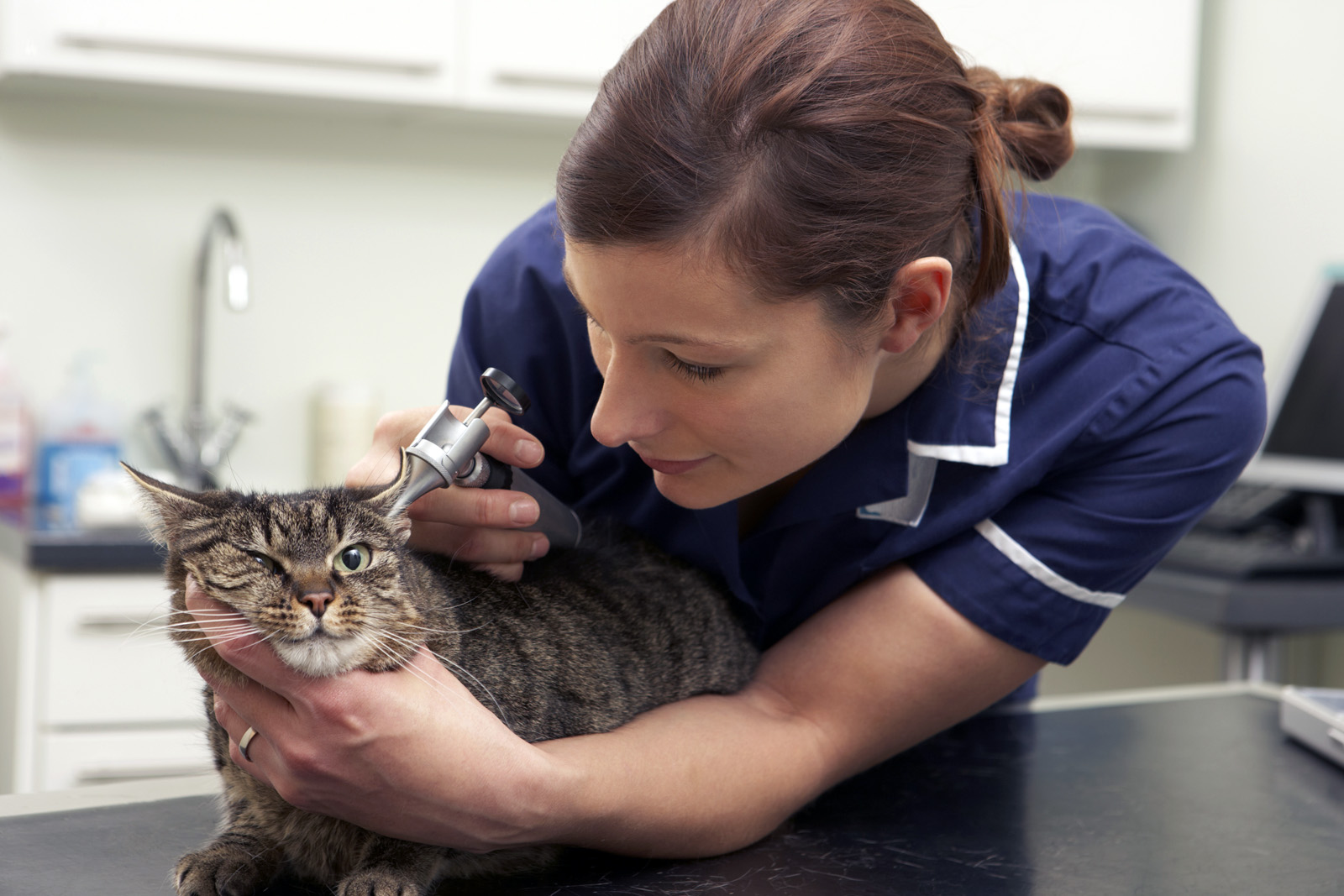 The Competition and Markets Authority (CMA) is proposing to launch a formal Market Investigation into anti-competitive practices in the UK’s £2bn veterinary industry (for pets rather than farm animals or horses). This follows a preliminary investigation which received 56 000 responses from pet owners and vet professionals. These responses reported huge rises in bills for treatment and medicines and corresponding rises in the cost of pet insurance.
The Competition and Markets Authority (CMA) is proposing to launch a formal Market Investigation into anti-competitive practices in the UK’s £2bn veterinary industry (for pets rather than farm animals or horses). This follows a preliminary investigation which received 56 000 responses from pet owners and vet professionals. These responses reported huge rises in bills for treatment and medicines and corresponding rises in the cost of pet insurance.
At the same time there has been a large increase in concentration in the industry. In 2013, independent vet practices accounted for 89% of the market; today, they account for only around 40%. Over the past 10 years, some 1500 of the UK’s 5000 vet practices had been acquired by six of the largest corporate groups. In many parts of the country, competition is weak; in others, it is non-existent, with just one of these large companies having a monopoly of veterinary services.
This market power has given rise to a number of issues. The CMA identifies the following:
- Of those practices checked, over 80% had no pricing information online, even for the most basic services. This makes is hard for pet owners to make decisions on treatment.
- Pet owners potentially overpay for medicines, many of which can be bought online or over the counter in pharmacies at much lower prices, with the pet owners merely needing to know the correct dosage. When medicines require a prescription, often it is not made clear to the owners that they can take a prescription elsewhere, and owners end up paying high prices to buy medicines directly from the vet practice.
- Even when there are several vet practices in a local area, they are often owned by the same company and hence there is no price competition. The corporate group often retains the original independent name when it acquires the practice and thus is is not clear to pet owners that ownership has changed. They may think there is local competition when there is not.
 Often the corporate group provides the out-of-hours service, which tends to charge very high prices for emergency services. If there is initially an independent out-of-hours service provider, it may be driven out of business by the corporate owner of day-time services only referring pet owners to its own out-of-hours service.
Often the corporate group provides the out-of-hours service, which tends to charge very high prices for emergency services. If there is initially an independent out-of-hours service provider, it may be driven out of business by the corporate owner of day-time services only referring pet owners to its own out-of-hours service.- The corporate owners may similarly provide other services, such as specialist referral centres, diagnostic labs, animal hospitals and crematoria. By referring pets only to those services owned by itself, this crowds out independents and provides a barrier to the entry of new independents into these parts of the industry.
- Large corporate groups have the incentive to act in ways which may further reduce competition and choice and drive up their profits. They may, for example, invest in advanced equipment, allowing them to provide more sophisticated but high-cost treatment. Simpler, lower-cost treatments may not be offered to pet owners.
- The higher prices in the industry have led to large rises in the cost of pet insurance. These higher insurance costs are made worse by vets steering owners with pet insurance to choosing more expensive treatments for their pets than those without insurance. The Association of British Insurers notes that there has been a large rise in claims attributable to an increasing provision of higher-cost treatments.
- The industry suffers from acute staff shortages, which cuts down on the availability of services and allows practices to push up prices.
- Regulation by the Royal College of Veterinary Surgeons (RCVS) is weak in the area of competition and pricing.
The CMA’s formal investigation will examine the structure of the veterinary industry and the behaviour of the firms in the industry. As the CMA states:
In a well-functioning market, we would expect a range of suppliers to be able to inform consumers of their services and, in turn, consumers would act on the information they receive.
Market failures in the veterinary industry
The CMA’s concerns suggest that the market is not sufficiently competitive, with vet companies holding significant market power. This leads to higher prices for a range of vet services. However, the CMA’s analysis suggests that market failures in the industry extend beyond the simple question of market power and lack of competition.
A crucial market failure is asymmetry of information. The veterinary companies have much better information than pet owners. This is a classic principal–agent problem. The agent, in this case the vet (or vet company), has much better information than the principal, in this case the pet owner. This information can be used to the interests of the vet company, with pet owners being persuaded to purchase more extensive and expensive treatments than they might otherwise choose if they were better informed.
The principal–agent problem also arises in the context of the dependant nature of pets. They are the ones receiving the treatment and, in this context, are the principals. Their owners are the ones acquiring the treatment for them and hence are the pets’ agents. The question is whether the owners will always do the best thing for their pets. This raises philosophical questions of animal rights and whether owners should be required to protect the interests of their pets.
 Another information issue is the short-term perspective of many pet owners. They may purchase a young and healthy pet and assume that it will remain so. However, as the pet gets older, it is likely to face increasing health issues, with correspondingly increasing vet bills. But many owners do not consider such future bills when they purchase the pet. They suffer from what behavioural economists call ‘irrational exuberance’. Such exuberance may also occur when the owner of a sick pet is offered expensive treatment. They may over-optimistically assume that the treatment will be totally successful and that their pet will not need further treatment.
Another information issue is the short-term perspective of many pet owners. They may purchase a young and healthy pet and assume that it will remain so. However, as the pet gets older, it is likely to face increasing health issues, with correspondingly increasing vet bills. But many owners do not consider such future bills when they purchase the pet. They suffer from what behavioural economists call ‘irrational exuberance’. Such exuberance may also occur when the owner of a sick pet is offered expensive treatment. They may over-optimistically assume that the treatment will be totally successful and that their pet will not need further treatment.
Vets cite another information asymmetry. This concerns the costs they face in providing treatment. Many owners are unaware of these costs – costs that include rent, business rates, heating and lighting, staff costs, equipment costs, consumables (such as syringes, dressings, surgical gowns, antiseptic and gloves), VAT, and so on. Many of these costs have risen substantially in recent months and are reflected in the prices pet owners are charged. With people experiencing free health care for themselves from the NHS (or other national provider), this may make them feel that the price of pet health care is excessive.
Then there is the issue of inequality. Pets provide great benefits to many owners and contribute to owners’ well-being. If people on low incomes cannot afford high vet bills, they may either have to forgo having a pet, with the benefits it brings, or incur high vet bills that they ill afford or simply go without treatment for their pets.
 Finally, there are the external costs that arise when people abandon their pets with various health conditions. This has been a growing problem, with many people buying pets during lockdown when they worked from home, only to abandon them later when they have had to go back to the office or other workplace. The costs of treating or putting down such pets are born by charities or local authorities.
Finally, there are the external costs that arise when people abandon their pets with various health conditions. This has been a growing problem, with many people buying pets during lockdown when they worked from home, only to abandon them later when they have had to go back to the office or other workplace. The costs of treating or putting down such pets are born by charities or local authorities.
The CMA is consulting on its proposal to begin a formal Market Investigation. This closes on 11 April. If, in the light of its consultation, the Market Investigation goes ahead, the CMA will later report on its findings and may require the veterinary industry to adopt various measures. These could require vet groups to provide better information to owners, including what lower-cost treatments are available. But given the oligopolistic nature of the industry, it is unlikely to lead to significant reductions in vets bills.
Articles
- UK competition watchdog plans probe into veterinary market
Financial Times, Suzi Ring and Oliver Ralph (12/3/24)
 Vet prices: Investigation over concerns pet owners are being overcharged
Vet prices: Investigation over concerns pet owners are being overchargedSky News (12/3/24)
- UK watchdog plans formal investigation into vet pricing
The Guardian, Kalyeena Makortoff (12/3/24)
- ‘Eye-watering’ vet bills at chain-owned surgeries prompt UK watchdog review
The Guardian, Kalyeena Makortoff (7/9/23)
- Warning pet owners could be overpaying for medicine
BBC News, Lora Jones & Jim Connolly (12/3/24)
- I own a vet practice, owners complain about the spiralling costs of treatments, but I only make 5 -10% profit – here’s our expenditure breakdown
Mail Online, Alanah Khosla (14/3/24)
- Vets bills around the world: As big-name veterinary practices come under pressure for charging pet owners ‘eyewatering’ care costs, how do fees in Britain compare to other countries?
Mail Online, Rory Tingle, Dan Grennan and Katherine Lawton (13/3/24)
CMA documents
Questions
- How would you establish whether there is an abuse of market power in the veterinary industry?
- Explain what is meant by the principal–agent problem. Give some other examples both in economic and non-economic relationships.
- What market advantages do large vet companies have over independent vet practices?
- How might pet insurance lead to (a) adverse selection; (b) moral hazard? Explain. How might (i) insurance companies and (ii) vets help to tackle adverse selection and moral hazard?
- Find out what powers the CMA has to enforce its rulings.
- Search for vet prices and compare the prices charged by at least three vet practices. How would you account for the differences or similarities in prices?
 High-tech firms, such as Google, Amazon, Meta and Apple, have increasingly been gaining the attention of competition authorities across the world, and not in a good way! Over the past few years, competition authorities in the UK, USA and Europe have all opened various cases against Apple, with particular focus on its App Store (see, for example, a blog post on this site from 2021 about the Epic v. Apple case in the USA).
High-tech firms, such as Google, Amazon, Meta and Apple, have increasingly been gaining the attention of competition authorities across the world, and not in a good way! Over the past few years, competition authorities in the UK, USA and Europe have all opened various cases against Apple, with particular focus on its App Store (see, for example, a blog post on this site from 2021 about the Epic v. Apple case in the USA).
The lead-up to the €1.8 billion fine issued by the European Commission (Europe’s competition regulator) on the 4th March 2024, began in 2019 when music streaming provider, Spotify, filed a complaint against Apple, after years of being bound by the ‘unfair’ App Store rules imposed by Apple.1
 Apple’s App Store has traditionally served as the only platform through which application developers can distribute their apps to iOS users, and app developers have had no choice but to adhere to whatever rules are set by Apple. As iPhone and iPad users know, the App Store is the only way in which users can download apps to their iOS devices, establishing Apple’s App Store as a ‘gatekeeper’, as described in the European Commission’s (EC) press release expressing their initial concerns in April 2021.2 When it comes to music streaming apps, Apple not only serves as the exclusive platform for downloading these apps, but also has its own music streaming app, Apple Music, that competes with other music-streaming providers.
Apple’s App Store has traditionally served as the only platform through which application developers can distribute their apps to iOS users, and app developers have had no choice but to adhere to whatever rules are set by Apple. As iPhone and iPad users know, the App Store is the only way in which users can download apps to their iOS devices, establishing Apple’s App Store as a ‘gatekeeper’, as described in the European Commission’s (EC) press release expressing their initial concerns in April 2021.2 When it comes to music streaming apps, Apple not only serves as the exclusive platform for downloading these apps, but also has its own music streaming app, Apple Music, that competes with other music-streaming providers.
 This means that Apple holds a dominant position in the market for the distribution of music streaming apps to iOS users through its App Store. Being a dominant firm is not necessarily a problem. However, firms which hold a dominant position do have a special responsibility not to abuse their position. The EC found that Apple was abusing its dominant position in this market, with particular concerns about the rules it imposed on music streaming app developers.
This means that Apple holds a dominant position in the market for the distribution of music streaming apps to iOS users through its App Store. Being a dominant firm is not necessarily a problem. However, firms which hold a dominant position do have a special responsibility not to abuse their position. The EC found that Apple was abusing its dominant position in this market, with particular concerns about the rules it imposed on music streaming app developers.
Apple requires that app developers use Apple’s own in-app purchase system. This means that users must make any in-app purchases or subscriptions to music streaming apps through Apple’s system, subsequently subjecting app developers to a 30% commission fee. The EC found that this often led app developers to pass on these costs to consumers through an increase in prices.
Although users could still purchase subscriptions outside of the app, which may be cheaper for users as these payments will not be subject to commission, the EC found that Apple limits the ability for app developers to inform users about these alternative methods. For example, Apple prevented app developers from including links within their apps to their websites, where users could purchase subscriptions. The implications of this extends beyond increased prices for consumers, potentially resulting in a degraded user experience as well.
These restrictions imposed by Apple are examples of what are known as ‘anti-steering provisions’, and it is this conduct that led the Commission to issue the fine for the abuse of a dominant market position.
 Whilst this case has now been concluded, the spotlight is not off of Apple yet. The European Commission had required that all ‘gatekeepers’ must comply with their Digital Markets Act (DMA) by the 7 March 2024.3 One implication of this for Apple, is the requirement to allow third-party app stores on iOS devices.
Whilst this case has now been concluded, the spotlight is not off of Apple yet. The European Commission had required that all ‘gatekeepers’ must comply with their Digital Markets Act (DMA) by the 7 March 2024.3 One implication of this for Apple, is the requirement to allow third-party app stores on iOS devices.
Whilst Apple has agreed to this requirement, concerns have been raised about the accompanying measures which Apple will introduce. This includes varying terms for app developers based on whether or not they offer their app exclusively through Apple’s App Store. As outlined in a recent article,4 one implication is that app developers exceeding 1 million existing downloads through the Apple App Store will incur a fee of €0.50 per additional user if they opt to distribute their app also through a competing app store. This may act as a deterrent to popular app developers to offer their app through a competing store.
The success of a platform like an app store, relies greatly on generating ‘network effects’ – more users attract more developers, leading to more users, and so on. Therefore, not being able to offer some of the most popular apps would make it challenging for a new app store to compete effectively with Apple’s App Store.
Recently, Spotify, along with game developer Epic and others, have expressed various concerns about Apple’s compliance with the DMA in a letter to the EC.5 It will be interesting to see whether the EC is satisfied with Apple’s approach to comply with the requirements of the DMA.
References
- A Timeline: How we got here
Time to Play Fair (Spotify) (updated March 2024)
- Antitrust: Commission sends Statement of Objections to Apple on App Store rules for music streaming providers
EC Press Release (30/4/21)
- The Digital Markets Act
EC: Business, Economy, Euro DG
- Apple’s exclusionary app store scheme: An existential moment for the Digital Markets Act
VOXEU, Jacques Crémer, Paul Heidhues, Monika Schnitzer and Fiona Scott Morton (6/3/24)
- A Letter to the European Commission on Apple’s Lack of DMA Compliance
Time to Play Fair (Spotify) (1/3/24)
Articles
Questions
- Why might ‘anti-steering provisions’ that limit the ability of app developers to inform users of alternative purchasing methods be harmful to consumers?
- Why is the existence of Apple’s own music streaming service, Apple Music, particularly significant in the context of its role as the operator of the App Store?
- Reflect on the potential advantages and disadvantages of allowing third-party app stores on iOS devices, as mandated by the Digital Markets Act (DMA).
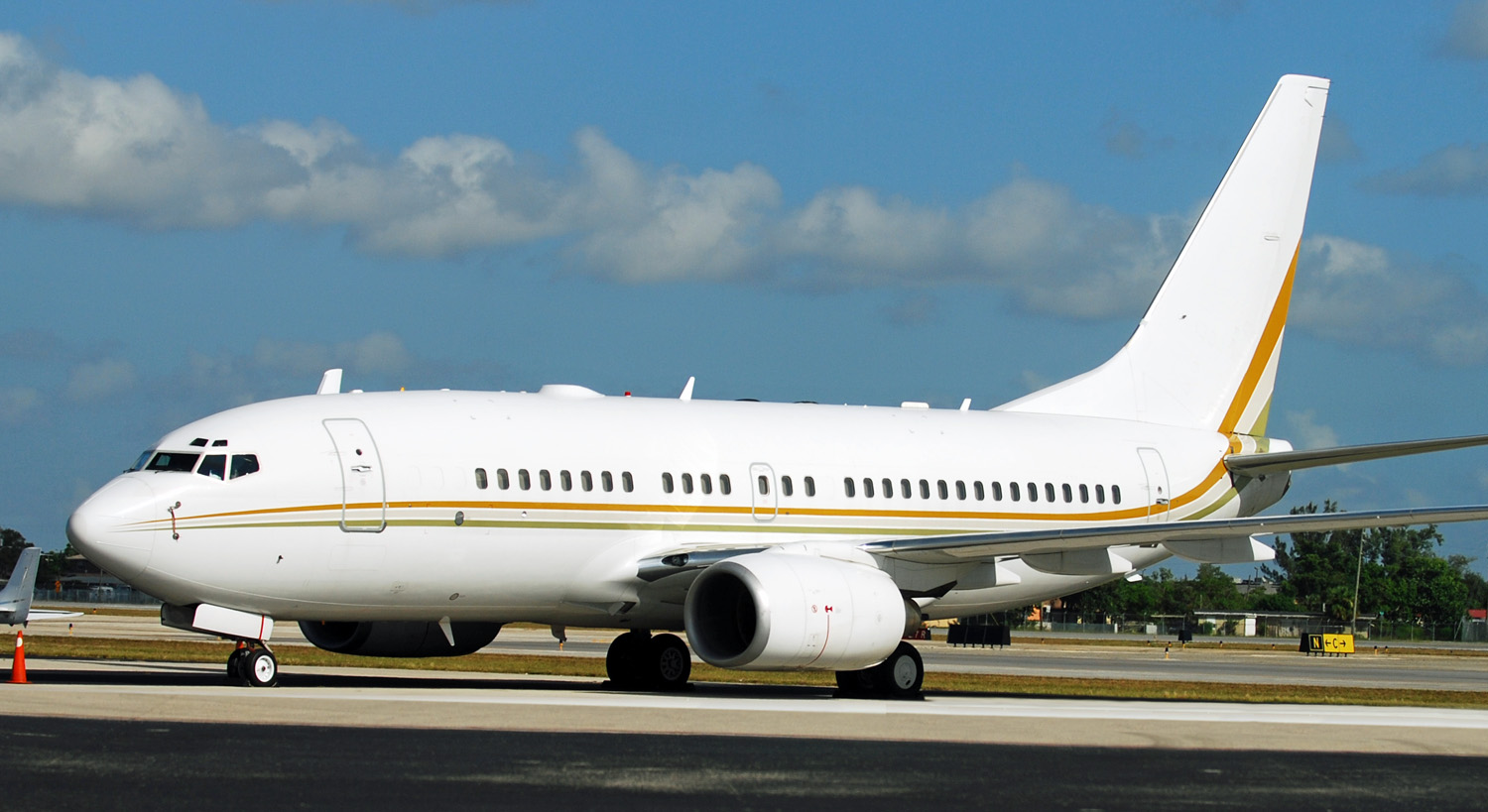 The traditional theory of the firm assumes that firms are profit maximisers. Although, in practice, decision-makers in firms are driven by a range of motives and objectives, profit remains a key objective for most firms – if not maximising profit, at least trying to achieve profit growth so as to satisfy shareholders, retain confidence in the company and prevent the share price from falling. After all, if the company is profitable, it is easier to fund investment, either from ploughed-back profit, borrowing or new share issue. And greater investment will help to drive profits in the future.
The traditional theory of the firm assumes that firms are profit maximisers. Although, in practice, decision-makers in firms are driven by a range of motives and objectives, profit remains a key objective for most firms – if not maximising profit, at least trying to achieve profit growth so as to satisfy shareholders, retain confidence in the company and prevent the share price from falling. After all, if the company is profitable, it is easier to fund investment, either from ploughed-back profit, borrowing or new share issue. And greater investment will help to drive profits in the future.
But does the pursuit of profit and shareholder value as the number-one objective actually lead to higher profit? It could be that a prime focus on other things such as consumer satisfaction, product design and value, innovation, safety, worker involvement and the local community could lead to greater long-term profit than an aggressive policy of marketing, cost cutting and financial rejigging – three of the commonest approaches to achieving greater profits.
Boeing disasters
In 2018 and 2019 there were two fatal crashes involving the new 737 MAX-8 aircraft. On 29 October 2018, Indonesia’s Lion Air Flight 610 crashed into the Java Sea; all 189 people on board died. On 10 March 2019, Ethiopian Airlines Flight 302 similarly crashed; all 157 people on board died. Both disasters were the result of a faulty automatic manoeuvring system. The company and its CEO, Dennis Muilenburg, knew about issues with the system, but preferred to keep planes flying while they sought to fix the issue. Grounding them would have cost the company money. But taking this gamble led to two fatal crashes. This damaged the company’s reputation and cost it billions of dollars.
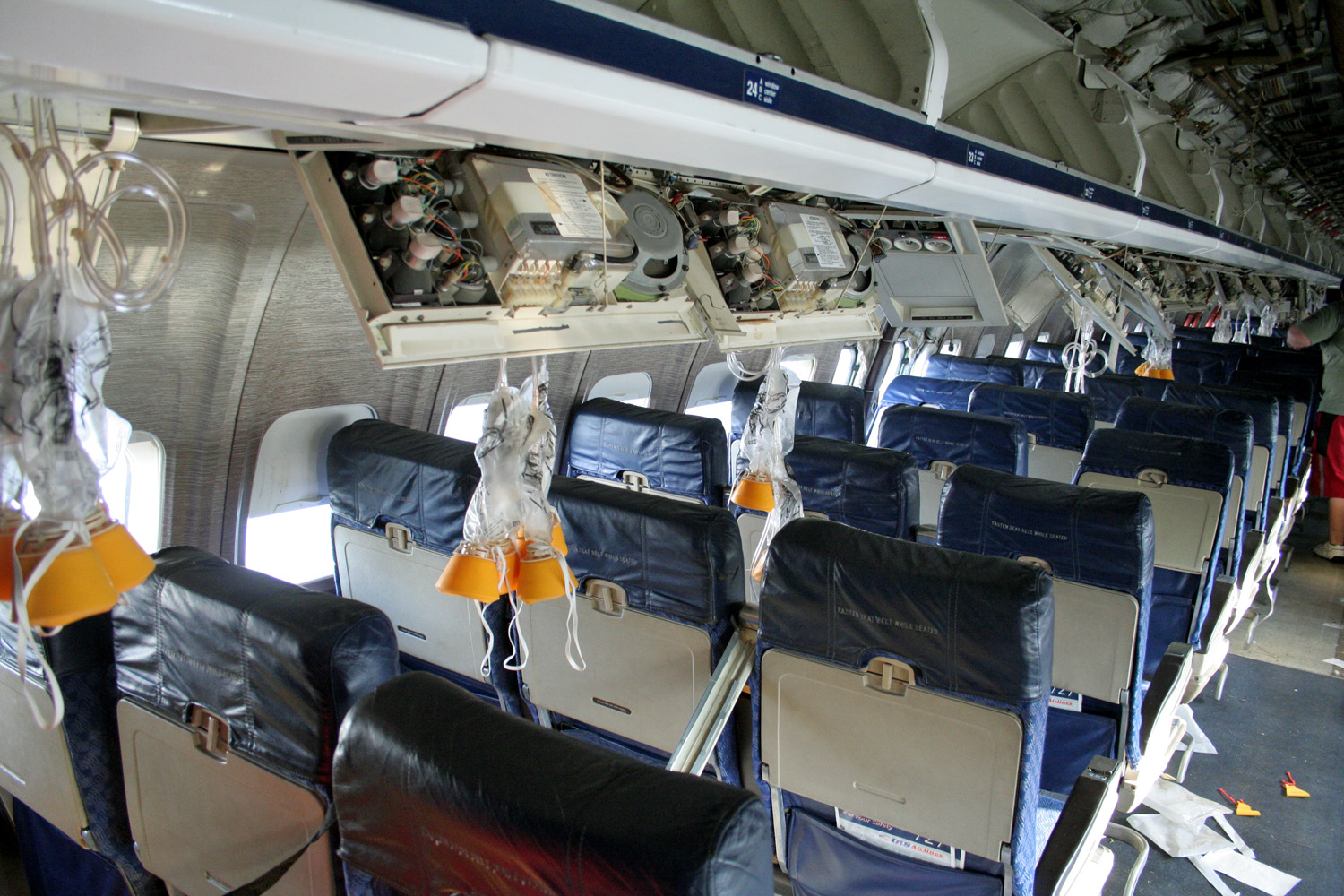 The US Securities and Exchange Commission (SEC) investigated the cases and found that the company had made false statements about the plane’s safety and had put ‘profits before people’. But putting profits first ended up in a huge fall in profits, with the 737 MAX grounded for 20 months.
The US Securities and Exchange Commission (SEC) investigated the cases and found that the company had made false statements about the plane’s safety and had put ‘profits before people’. But putting profits first ended up in a huge fall in profits, with the 737 MAX grounded for 20 months.
Since the crashes there have been several other issues with various critical systems, including stabilisation, engines, flight control systems, hydraulics and wiring. In December 2023, Boeing asked airlines to inspect its 737 MAX planes for a potential loose bolt in the rudder control system.
On 5 January 2024, Alaska Airlines Flight 1282 experienced an emergency. A window panel on the 737 MAX-9 aircraft, which replaced an unused emergency exit door, blew out and the cabin depressurised. Fortunately the plane was still climbing and had reached only just under 5000m – less than half of the cruising altitude of over 11 500m. The plane rapidly descended and safely returned to Portland International Airport without loss of life. Had the incident occurred at cruising altitude, the rush of air out of the plane would have been much greater. Passengers would be less likely to be wearing their seat belts and several people could have been sucked out.
The Federal Aviation Administration (FAA) temporarily grounded 171 MAX-9s for inspections. It found that several planes had loose bolts holding the panels in place and could potentially have suffered similar blow outs.
Profits rather than safety?
Critics have claimed that the corporate culture at Boeing prioritised profit over safety. This was made worse in 2001 when company headquarters moved from Seattle to Chicago but production remained at Seattle. The culture at headquarters became sharply focused on financial success. Boeing was under intense competition from Airbus, which announced its more fuel-efficient version of the A320, the A320neo, in 2010, with launch planned for 2015. Boeing’s more fuel-efficient version of the 737, the 737 MAX, was announced in 2011, scheduled for first delivery in 2017. Since then, Boeing has been keen to get the 737 MAX to customers as quickly as possible. Also, Boeing has sought to cut manufacturing costs to keep prices competitive with Airbus.
Despite warnings from some Boeing employees that this competition was leading to corners being cut that compromised safety, Boeing management continued to push for more rapid and cheaper production to fight the competition from Airbus.
The aircraft industry is regulated in the USA by the Federal Aviation Administration (FAA). In 2020, the House Committee on Transportation and Infrastructure produced a detailed report on the industry. It found that the FAA delegated too much safety certification work to Boeing. This was a case of regulatory capture. It was also accused of sharing the goal of promoting the production of US-based Boeing in its competition with European-based Airbus.
Effects on profits
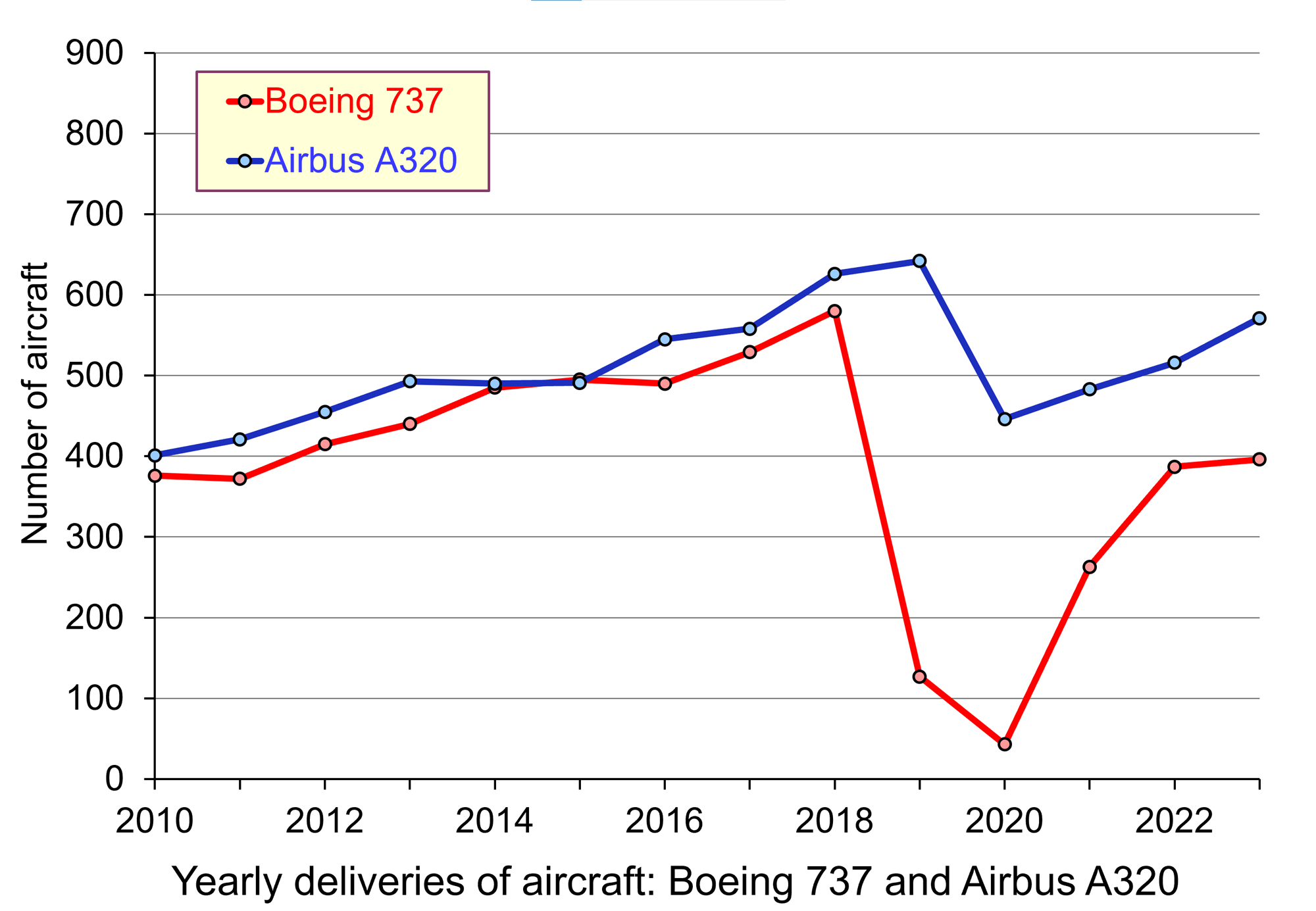 But rather than a focus on profit leading to greater profits, safety issues have led to groundings of 737s, a fall in sales and a fall in profits. The first chart shows deliveries of 737s slightly lagging A320s from 2010 to 2018. Since then deliveries of 737s have fallen well behind A320s. In terms of orders for all planes, Boeing was ahead of Airbus in 2018 (893 compared with 747). Since then, Boeing has significantly lagged behind Airbus and in 2019 and 2020 cancellations exceeded new orders. The January 2024 incident and subsequent groundings are likely to erode confidence, orders and profits even further.
But rather than a focus on profit leading to greater profits, safety issues have led to groundings of 737s, a fall in sales and a fall in profits. The first chart shows deliveries of 737s slightly lagging A320s from 2010 to 2018. Since then deliveries of 737s have fallen well behind A320s. In terms of orders for all planes, Boeing was ahead of Airbus in 2018 (893 compared with 747). Since then, Boeing has significantly lagged behind Airbus and in 2019 and 2020 cancellations exceeded new orders. The January 2024 incident and subsequent groundings are likely to erode confidence, orders and profits even further.
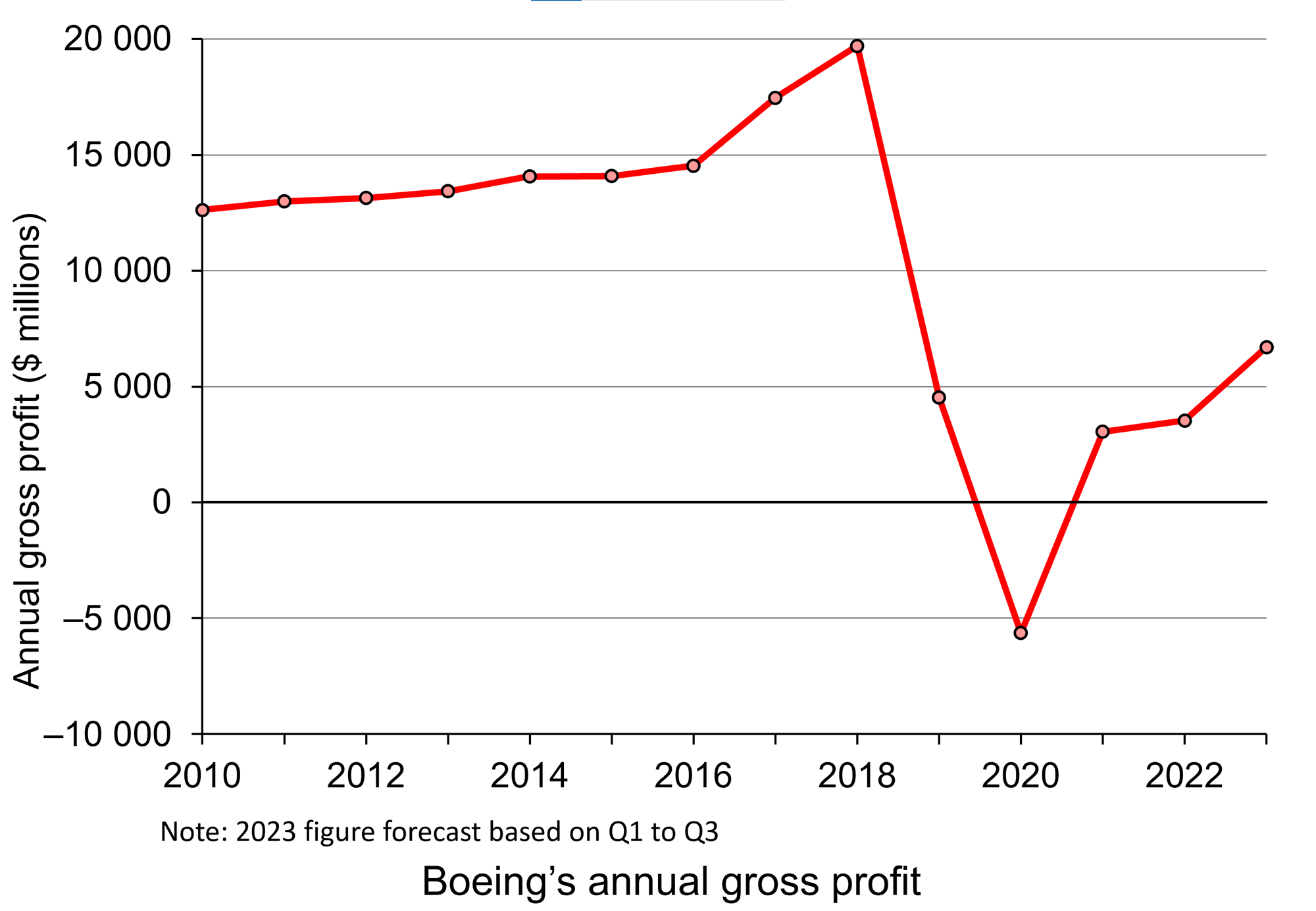 As you can see from the second chart, profits fell substantially in 2019, and with COVID fell again in 2020. They have not recovered to previous levels since. Depending on how the market responds to the issue of loose panel bolts on the MAX-9, profits could well fall again in 2024. There will almost certainly be a further erosion of confidence and probably of orders.
As you can see from the second chart, profits fell substantially in 2019, and with COVID fell again in 2020. They have not recovered to previous levels since. Depending on how the market responds to the issue of loose panel bolts on the MAX-9, profits could well fall again in 2024. There will almost certainly be a further erosion of confidence and probably of orders.
The Boeing story is a salutary lesson in how not to achieve long-term profit. A focus on design, quality and reliability may be a better means to achieving long-term profit growth than trying to appeal to shareholders by increasing short-term profits through aggressive cost cutting and hoping that this will not affect quality.
Video and audio
Articles
- ‘All those agencies failed us’: inside the terrifying downfall of Boeing
The Guardian, Charles Bramesco (22/2/22)
- A terrifying 10 minute flight adds to years of Boeing’s quality control problems
CNN, Chris Isidore (8/1/24)
- When A Company Prioritizes Profit Over People: Boeing CEO Tells Congress That Safety Is ‘Not Our Business Model’
Forbes, Jack Kelly (30/10/19)
- ‘Boeing played Russian roulette with people’s lives’
BBC News, Theo Leggett and Tom Burridge (November 2020)
- 737 Max: Boeing refutes new safety concerns
BBC News, Theo Leggett (26/11/21)
- 737 Max: Boeing to pay $200m over charges it misled investors
BBC News, Monica Miller (23/9/22)
- Boeing’s mid-flight blowout a big problem for company
BBC News, Theo Leggett (8/1/24)
- Boeing: US regulator to increase oversight of firm after blowout
BBC News (12/1/24)
- Boeing’s 737 Max Is a Saga of Capitalism Gone Awry
International New York Times, via Deccan Herald, David Gelles (24/11/20)
- Boeing and a dramatic change of direction
johnkay.com, John Kay (10/12/03)
- Congressional report faults Boeing, FAA for 737 Max failures, just as regulators close in on recertification
CNBC, Leslie Josephs (16/9/20)
- Boeing 737 Max: The FAA wanted a safe plane – but didn’t want to hurt America’s biggest exporter either
The Conversation, Susan Webb Yackee and Simon F Haeder (22/3/19)
- Boeing needs to get real: the 737 Max should probably be scrapped
The Conversation, ManMohan S Sodhi (12/1/24)
- Boeing: How much trouble is the company in?
BBC News, Theo Leggett (17/3/24)
Information
Questions
- Why is the pursuit of long-run profit likely to result in different decisions from the pursuit of short-run profit?
- How has Airbus’s strategy differed from that of Boeing?
- How would you summarise Boeing management’s attitude towards risk?
- Is it important to locate senior management of a company at its manufacturing base?
- What is regulatory capture? Is it fair to say that the FAA was captured by Boeing?
- Should Boeing scrap the 737 MAX and design a new narrow-body plane?
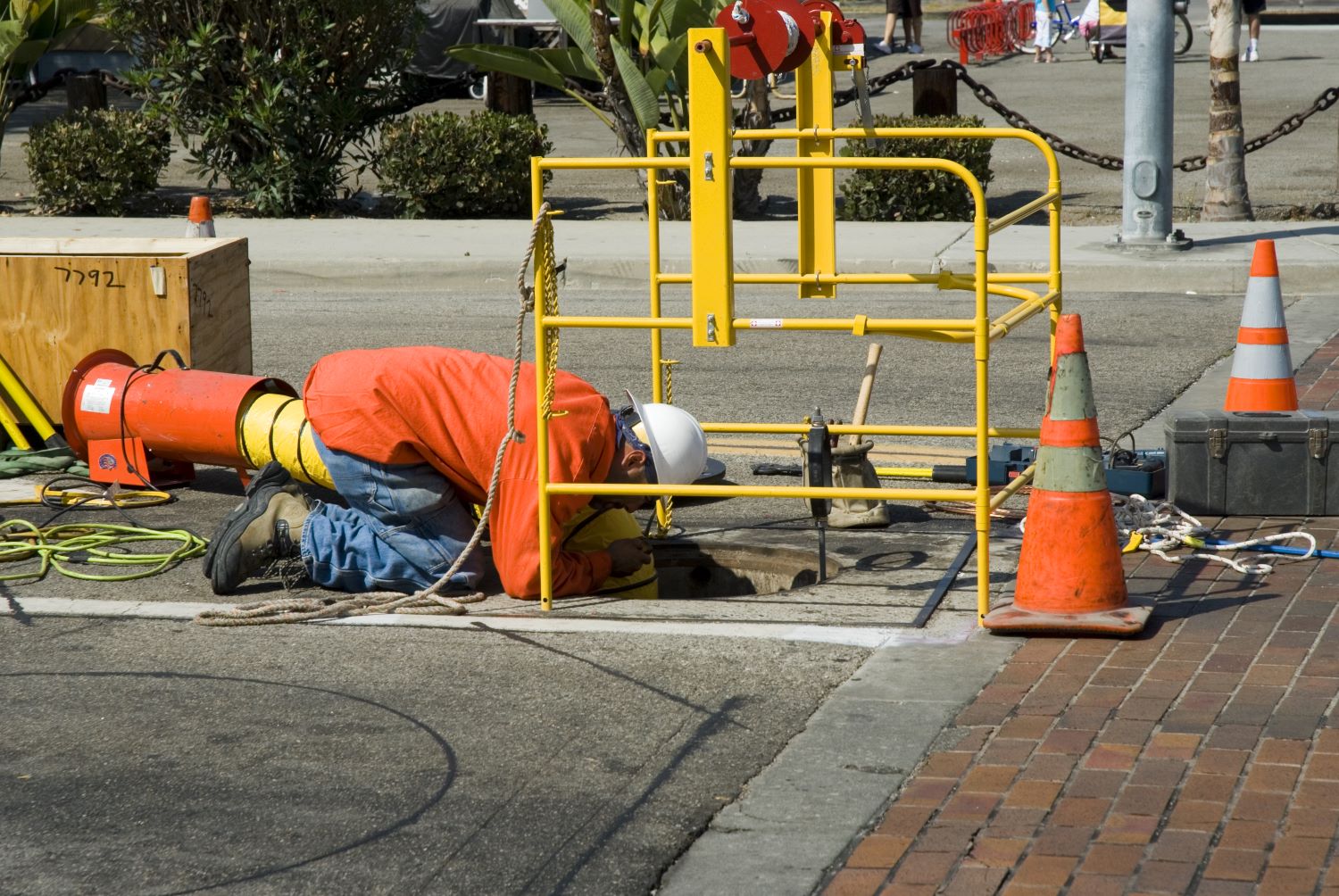 You may have recently noticed construction workers from different businesses digging up the roads/pavements near where you live. You may also have noticed them laying fibre optic cables. Why has this been happening? Does it make economic sense for different companies to dig up the same stretch of pavement and lay similar cables next to one another?
You may have recently noticed construction workers from different businesses digging up the roads/pavements near where you live. You may also have noticed them laying fibre optic cables. Why has this been happening? Does it make economic sense for different companies to dig up the same stretch of pavement and lay similar cables next to one another?
For many years the UK had one national fixed communication network that was owned by British Telecom (BT) – the traditional phone landline made from copper wire. This is now operated by OpenReach – part of the BT group but a legally separate division. In addition to this national infrastructure, Virgin Media (formed in 2007 from the merged cable operators, Telewest and NTL) has gradually built up a rival fixed broadband network that now covers just over 50 per cent of the country.
Although customers have only had very limited choice over which fixed communication network to use, they have had far greater choice over which Internet service provider (ISP) to sign up for. This has been possible as the industry regulator, Ofcom, forces OpenReach to provide rival ISPs such as Sky Broadband, TalkTalk and Zen with access to its network.
Expansion of the fibre optic network
 Recent government policy has tried to encourage and incentivise the replacement of the copper wire network with one that is fully fibre. This is often referred to as Fibre to the Premises (FTTP) or Fibre to the Home (FTTH). A fixed network of fully fibre broadband enables much faster download speeds and many argue that it is vital for the future competitiveness of the UK economy.
Recent government policy has tried to encourage and incentivise the replacement of the copper wire network with one that is fully fibre. This is often referred to as Fibre to the Premises (FTTP) or Fibre to the Home (FTTH). A fixed network of fully fibre broadband enables much faster download speeds and many argue that it is vital for the future competitiveness of the UK economy.
Replacing the existing fixed communication network with fibre optic cables is expensive. It can involve major civil works: i.e. the digging up of roads and pavements to install new ducts to lay the fibre optic cables inside.
Over a hundred companies, that are not part of either OpenReach or Virgin Media O2 (the parent company of Virgin Media), have recently been digging up pavements/roads and laying new fibre optic cables. Known as alternative network providers (altnets) or independent networks, these businesses vary in size, with many of them securing large loans from banks and private investors. By the middle of 2023, 2.5 million premises in the UK had access to at least two or more of these independent networks.
After a slow initial response to the altnets, OpenReach has recently responded by rapidly installing FTTP. The business is currently building 62 000 connections every week and plans to have 25 million premises connected by the end of 2026. In July 2022, Virgin Media O2 announced that it was establishing a new joint venture with InfraVia Capital Partners. Called Nexfibre, this business aims to connect 5 million premises to FTTP by 2026.
Is the fibre optic network a natural monopoly?
Some people argue that the fixed communication network is an example of a natural monopoly – an industry where a single firm can supply the whole market at a lower average cost than two or more firms. To what extent is this true?
An industry is a natural monopoly where the minimum efficient scale of production (MES) is larger than the market demand for the good/service. This is more likely to occur where there are significant economies of scale. Digging up roads/pavements, installing new ducts and laying fibre optic cable are clear examples of fixed costs. Once the network is built, the marginal cost of supplying customers is relatively small. Therefore, this industry has significant economies of scale and a relatively large MES. This has led many people to argue that building rival fixed communication networks is wasteful duplication and will lead to higher costs and prices.
However, when judging if a sector is a natural monopoly, it is always important to remember that a comparison needs to be made between the MES and the size of the market. An industry could have significant economies of scale, but not be an example of a natural monopoly if the market demand is significantly larger than the MES.
 In the case of the fixed communication network, the size of the market will vary significantly between different regions of the country. In densely populated urban areas, such as large towns and cities, the demand for services provided via these networks is likely to be relatively large. Therefore, the MES could be smaller than the size of the market, making competition between network suppliers both possible and desirable. For example, competition may incentivise firms to innovate, become more efficient and reduce costs.
In the case of the fixed communication network, the size of the market will vary significantly between different regions of the country. In densely populated urban areas, such as large towns and cities, the demand for services provided via these networks is likely to be relatively large. Therefore, the MES could be smaller than the size of the market, making competition between network suppliers both possible and desirable. For example, competition may incentivise firms to innovate, become more efficient and reduce costs.
Research undertaken for the government by the consultancy business, Frontier Economics, found that at least a third of UK households live in areas where competition between three or more different networks is economically desirable.
By contrast, in more sparsely populated rural areas, demand for the services provided by these networks will be smaller. The fixed costs per household of installing the network over longer distances will also be larger. Therefore, the MES is more likely to be greater than the size of the market.
The same research undertaken by Frontier Economics found that around 10 per cent of households live in areas where the fixed communication network is a natural monopoly. The demand and cost conditions for another 10 per cent of households meant it is not commercially viable to have any suppliers.
Therefore, policies towards the promotion of competition, regulation, and government support for the fixed communication network might have to be adjusted depending on the specific demand and cost conditions in a particular region.
Articles
Review
Questions
- Explain the difference between fixed and wireless communication networks.
- Draw a diagram to illustrate a profit-maximising natural monopoly. Outline some of the implications for allocative efficiency.
- Discuss some of the issues with regulating natural monopolies, paying particular attention to price regulation.
- The term ‘overbuild’ is often used to describe a situation where more than one fibre broadband network is being constructed in the same place. Some people argue that incumbent network suppliers deliberately choose to use this term to imply that the outcome is harmful for society. Discuss this argument.
- An important part of government policy in this sector has been the Duct and Pole Access Strategy (DPA). Illustrate the impact of this strategy on the average cost curve and the minimum efficient scale of production for fibre broadband networks.
- Draw a diagram to illustrate a region where (a) it is economically viable to have two or more fibre optic broadband network suppliers and (b) where it is commercially unviable to have any broadband network suppliers without government support.
- Some people argue that network competition provides strong incentives for firms to innovate, to become more efficient and reduce costs. Draw a diagram to illustrate this argument.
- Explain why many ‘altnets’ are so opposed to OpenReach’s new ‘Equinox 2’ pricing scheme for its fibre network.
 In September 2023, the Stonegate Group, the largest pub company in the UK with around 4,500 premises, announced that it was going to start increasing the pint of beer by 20p during busy periods. There was an immediate backlash on social media with many customers calling on people to boycott Stonegate’s pubs such as the Slug & Lettuce and Yates.
In September 2023, the Stonegate Group, the largest pub company in the UK with around 4,500 premises, announced that it was going to start increasing the pint of beer by 20p during busy periods. There was an immediate backlash on social media with many customers calling on people to boycott Stonegate’s pubs such as the Slug & Lettuce and Yates.
This announcement is an example of dynamic pricing, where firms with market power adjust prices relatively quickly in response to changing market conditions: i.e. to changes in demand and supply.
Traditionally, prices set by firms in most retail markets have been less flexible. They may eventually adjust to changing market conditions, but this could take weeks or even months. If a product proves to be popular on a particular day or time, firms have typically left the price unchanged with the item selling out and customers facing empty shelves. If the product is unpopular, then the firm is left with unsold stock.
One business that makes extensive use of dynamic pricing is Amazon. Prices for popular items on Amazon Marketplace change every 10 minutes and can fluctuate by more than 20 per cent in just one hour.
Conditions for dynamic pricing to operate
The Amazon example helps to illustrate the conditions that must be in place for a firm to implement dynamic pricing successfully. These include:
- The capacity to collect and process large amounts of accurate real-time data on the demand for and supply of particular items i.e. the number of sales or the interest in the product.
- The ability to adjust prices in a timely manner in response to changing market conditions indicated by the data.
- Effectively communicating the potential advantages of the pricing strategy to consumers.
Consumer attitudes
 The last point is an interesting one. As the Stonegate example illustrates, consumers tend to dislike dynamic pricing, especially when price rises reflect increases in demand. A previous article on this website discussed the unpopularity of dynamic pricing amongst fans in the ticket market for live musical events.
The last point is an interesting one. As the Stonegate example illustrates, consumers tend to dislike dynamic pricing, especially when price rises reflect increases in demand. A previous article on this website discussed the unpopularity of dynamic pricing amongst fans in the ticket market for live musical events.
The precise reason for the increase in demand, can also have an impact on consumer attitudes. For example, following a mass shooting at a subway station in New York in April 2022, the authorities shut down the underground system. This led to a surge in demand for taxis and this was picked up by the algorithm/software used by Uber’s dynamic pricing system. Fares for Uber cars began to rise rapidly, and people started to post complaints on social media. Uber responded by disabling the dynamic pricing system and capping prices across the city. It also announced that it would refund customers who were charged higher prices after the subway system shut down.
There is a danger for businesses that if they fail to communicate the policy effectively, annoyed customers may respond by shopping elsewhere. However, if it is implemented successfully then it can help businesses to increase their revenue and may also have some advantages for consumers.
The growing popularity of dynamic pricing
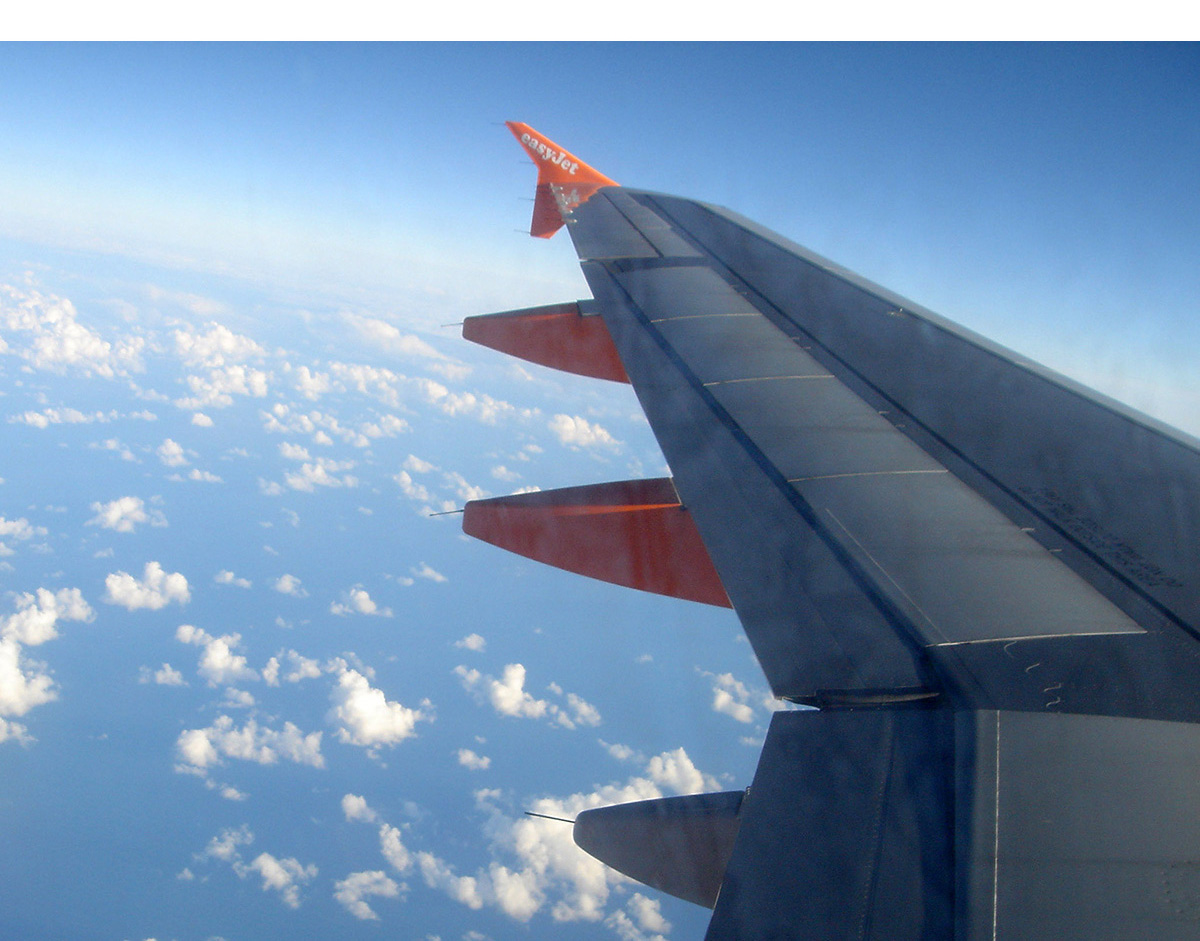 It has been widely used in airline and hotel industries for many years. Robert Cross, who chairs a revenue management company predicts that ‘It will eventually be everywhere’.
It has been widely used in airline and hotel industries for many years. Robert Cross, who chairs a revenue management company predicts that ‘It will eventually be everywhere’.
More businesses in the UK appear to be using dynamic pricing. In a consumer confidence survey undertaken for Barclays in September 2023, 47 per cent of the respondents had noticed more examples of companies raising prices for goods/services in response to higher demand at peak times.
It has traditionally been more difficult for bricks-and-mortar retailers to implement dynamic pricing because of the costs of continually changing prices (so-called ‘menu costs’). However, this might change with the increasing use of electronic shelf labels.
It will be interesting to see if dynamic pricing becomes more widespread in the future or whether opposition from consumers limits its use.
Articles
Questions
- Explain the difference between surge and dynamic pricing.
- Using a diagram, explain how dynamic pricing can increase a firm’s revenue.
- Discuss both the advantages and disadvantages for consumers of firms using dynamic pricing.
- How might dynamic pricing influence consumer behaviour if it alters their expectations about future price changes.
- There is some evidence that the use of dynamic pricing is less unpopular amongst 18–24-year-olds than other age groups. Suggest some possible reasons why this might be the case.
- Using the concept of loss aversion, consider some different ways that a business could present a new dynamic pricing policy to its customers.
 The Competition and Markets Authority (CMA) is proposing to launch a formal Market Investigation into anti-competitive practices in the UK’s £2bn veterinary industry (for pets rather than farm animals or horses). This follows a preliminary investigation which received 56 000 responses from pet owners and vet professionals. These responses reported huge rises in bills for treatment and medicines and corresponding rises in the cost of pet insurance.
The Competition and Markets Authority (CMA) is proposing to launch a formal Market Investigation into anti-competitive practices in the UK’s £2bn veterinary industry (for pets rather than farm animals or horses). This follows a preliminary investigation which received 56 000 responses from pet owners and vet professionals. These responses reported huge rises in bills for treatment and medicines and corresponding rises in the cost of pet insurance. Often the corporate group provides the out-of-hours service, which tends to charge very high prices for emergency services. If there is initially an independent out-of-hours service provider, it may be driven out of business by the corporate owner of day-time services only referring pet owners to its own out-of-hours service.
Often the corporate group provides the out-of-hours service, which tends to charge very high prices for emergency services. If there is initially an independent out-of-hours service provider, it may be driven out of business by the corporate owner of day-time services only referring pet owners to its own out-of-hours service. Another information issue is the short-term perspective of many pet owners. They may purchase a young and healthy pet and assume that it will remain so. However, as the pet gets older, it is likely to face increasing health issues, with correspondingly increasing vet bills. But many owners do not consider such future bills when they purchase the pet. They suffer from what behavioural economists call ‘irrational exuberance’. Such exuberance may also occur when the owner of a sick pet is offered expensive treatment. They may over-optimistically assume that the treatment will be totally successful and that their pet will not need further treatment.
Another information issue is the short-term perspective of many pet owners. They may purchase a young and healthy pet and assume that it will remain so. However, as the pet gets older, it is likely to face increasing health issues, with correspondingly increasing vet bills. But many owners do not consider such future bills when they purchase the pet. They suffer from what behavioural economists call ‘irrational exuberance’. Such exuberance may also occur when the owner of a sick pet is offered expensive treatment. They may over-optimistically assume that the treatment will be totally successful and that their pet will not need further treatment. Finally, there are the external costs that arise when people abandon their pets with various health conditions. This has been a growing problem, with many people buying pets during lockdown when they worked from home, only to abandon them later when they have had to go back to the office or other workplace. The costs of treating or putting down such pets are born by charities or local authorities.
Finally, there are the external costs that arise when people abandon their pets with various health conditions. This has been a growing problem, with many people buying pets during lockdown when they worked from home, only to abandon them later when they have had to go back to the office or other workplace. The costs of treating or putting down such pets are born by charities or local authorities. Vet prices: Investigation over concerns pet owners are being overcharged
Vet prices: Investigation over concerns pet owners are being overcharged High-tech firms, such as Google, Amazon, Meta and Apple, have increasingly been gaining the attention of competition authorities across the world, and not in a good way! Over the past few years, competition authorities in the UK, USA and Europe have all opened various cases against Apple, with particular focus on its App Store (see, for example,
High-tech firms, such as Google, Amazon, Meta and Apple, have increasingly been gaining the attention of competition authorities across the world, and not in a good way! Over the past few years, competition authorities in the UK, USA and Europe have all opened various cases against Apple, with particular focus on its App Store (see, for example,  Apple’s App Store has traditionally served as the only platform through which application developers can distribute their apps to iOS users, and app developers have had no choice but to adhere to whatever rules are set by Apple. As iPhone and iPad users know, the App Store is the only way in which users can download apps to their iOS devices, establishing Apple’s App Store as a ‘gatekeeper’, as described in the European Commission’s (EC) press release expressing their initial concerns in April 2021.2 When it comes to music streaming apps, Apple not only serves as the exclusive platform for downloading these apps, but also has its own music streaming app, Apple Music, that competes with other music-streaming providers.
Apple’s App Store has traditionally served as the only platform through which application developers can distribute their apps to iOS users, and app developers have had no choice but to adhere to whatever rules are set by Apple. As iPhone and iPad users know, the App Store is the only way in which users can download apps to their iOS devices, establishing Apple’s App Store as a ‘gatekeeper’, as described in the European Commission’s (EC) press release expressing their initial concerns in April 2021.2 When it comes to music streaming apps, Apple not only serves as the exclusive platform for downloading these apps, but also has its own music streaming app, Apple Music, that competes with other music-streaming providers.  This means that Apple holds a dominant position in the market for the distribution of music streaming apps to iOS users through its App Store. Being a dominant firm is not necessarily a problem. However, firms which hold a dominant position do have a special responsibility not to abuse their position. The EC found that Apple was abusing its dominant position in this market, with particular concerns about the rules it imposed on music streaming app developers.
This means that Apple holds a dominant position in the market for the distribution of music streaming apps to iOS users through its App Store. Being a dominant firm is not necessarily a problem. However, firms which hold a dominant position do have a special responsibility not to abuse their position. The EC found that Apple was abusing its dominant position in this market, with particular concerns about the rules it imposed on music streaming app developers.  Whilst this case has now been concluded, the spotlight is not off of Apple yet. The European Commission had required that all ‘gatekeepers’ must comply with their Digital Markets Act (DMA) by the 7 March 2024.3 One implication of this for Apple, is the requirement to allow third-party app stores on iOS devices.
Whilst this case has now been concluded, the spotlight is not off of Apple yet. The European Commission had required that all ‘gatekeepers’ must comply with their Digital Markets Act (DMA) by the 7 March 2024.3 One implication of this for Apple, is the requirement to allow third-party app stores on iOS devices. The traditional theory of the firm assumes that firms are profit maximisers. Although, in practice, decision-makers in firms are driven by a range of motives and objectives, profit remains a key objective for most firms – if not maximising profit, at least trying to achieve profit growth so as to satisfy shareholders, retain confidence in the company and prevent the share price from falling. After all, if the company is profitable, it is easier to fund investment, either from ploughed-back profit, borrowing or new share issue. And greater investment will help to drive profits in the future.
The traditional theory of the firm assumes that firms are profit maximisers. Although, in practice, decision-makers in firms are driven by a range of motives and objectives, profit remains a key objective for most firms – if not maximising profit, at least trying to achieve profit growth so as to satisfy shareholders, retain confidence in the company and prevent the share price from falling. After all, if the company is profitable, it is easier to fund investment, either from ploughed-back profit, borrowing or new share issue. And greater investment will help to drive profits in the future. The US Securities and Exchange Commission (SEC) investigated the cases and found that the company had made false statements about the plane’s safety and had put ‘profits before people’. But putting profits first ended up in a huge fall in profits, with the 737 MAX grounded for 20 months.
The US Securities and Exchange Commission (SEC) investigated the cases and found that the company had made false statements about the plane’s safety and had put ‘profits before people’. But putting profits first ended up in a huge fall in profits, with the 737 MAX grounded for 20 months.  But rather than a focus on profit leading to greater profits, safety issues have led to groundings of 737s, a fall in sales and a fall in profits. The first chart shows deliveries of 737s slightly lagging A320s from 2010 to 2018. Since then deliveries of 737s have fallen well behind A320s. In terms of orders for all planes, Boeing was ahead of Airbus in 2018 (893 compared with 747). Since then, Boeing has significantly lagged behind Airbus and in 2019 and 2020 cancellations exceeded new orders. The January 2024 incident and subsequent groundings are likely to erode confidence, orders and profits even further.
But rather than a focus on profit leading to greater profits, safety issues have led to groundings of 737s, a fall in sales and a fall in profits. The first chart shows deliveries of 737s slightly lagging A320s from 2010 to 2018. Since then deliveries of 737s have fallen well behind A320s. In terms of orders for all planes, Boeing was ahead of Airbus in 2018 (893 compared with 747). Since then, Boeing has significantly lagged behind Airbus and in 2019 and 2020 cancellations exceeded new orders. The January 2024 incident and subsequent groundings are likely to erode confidence, orders and profits even further. As you can see from the second chart, profits fell substantially in 2019, and with COVID fell again in 2020. They have not recovered to previous levels since. Depending on how the market responds to the issue of loose panel bolts on the MAX-9, profits could well fall again in 2024. There will almost certainly be a further erosion of confidence and probably of orders.
As you can see from the second chart, profits fell substantially in 2019, and with COVID fell again in 2020. They have not recovered to previous levels since. Depending on how the market responds to the issue of loose panel bolts on the MAX-9, profits could well fall again in 2024. There will almost certainly be a further erosion of confidence and probably of orders. You may have recently noticed construction workers from different businesses digging up the roads/pavements near where you live. You may also have noticed them laying fibre optic cables. Why has this been happening? Does it make economic sense for different companies to dig up the same stretch of pavement and lay similar cables next to one another?
You may have recently noticed construction workers from different businesses digging up the roads/pavements near where you live. You may also have noticed them laying fibre optic cables. Why has this been happening? Does it make economic sense for different companies to dig up the same stretch of pavement and lay similar cables next to one another? Recent government policy has tried to encourage and incentivise the replacement of the copper wire network with one that is fully fibre. This is often referred to as Fibre to the Premises (FTTP) or Fibre to the Home (FTTH). A fixed network of fully fibre broadband enables much faster download speeds and many argue that it is vital for the future competitiveness of the UK economy.
Recent government policy has tried to encourage and incentivise the replacement of the copper wire network with one that is fully fibre. This is often referred to as Fibre to the Premises (FTTP) or Fibre to the Home (FTTH). A fixed network of fully fibre broadband enables much faster download speeds and many argue that it is vital for the future competitiveness of the UK economy. In the case of the fixed communication network, the size of the market will vary significantly between different regions of the country. In densely populated urban areas, such as large towns and cities, the demand for services provided via these networks is likely to be relatively large. Therefore, the MES could be smaller than the size of the market, making competition between network suppliers both possible and desirable. For example, competition may incentivise firms to innovate, become more efficient and reduce costs.
In the case of the fixed communication network, the size of the market will vary significantly between different regions of the country. In densely populated urban areas, such as large towns and cities, the demand for services provided via these networks is likely to be relatively large. Therefore, the MES could be smaller than the size of the market, making competition between network suppliers both possible and desirable. For example, competition may incentivise firms to innovate, become more efficient and reduce costs.  In September 2023, the Stonegate Group, the largest pub company in the UK with around 4,500 premises, announced that it was going to start increasing the pint of beer by 20p during busy periods. There was an immediate backlash on social media with many customers calling on people to boycott Stonegate’s pubs such as the Slug & Lettuce and Yates.
In September 2023, the Stonegate Group, the largest pub company in the UK with around 4,500 premises, announced that it was going to start increasing the pint of beer by 20p during busy periods. There was an immediate backlash on social media with many customers calling on people to boycott Stonegate’s pubs such as the Slug & Lettuce and Yates. The last point is an interesting one. As the Stonegate example illustrates, consumers tend to dislike dynamic pricing, especially when price rises reflect increases in demand. A
The last point is an interesting one. As the Stonegate example illustrates, consumers tend to dislike dynamic pricing, especially when price rises reflect increases in demand. A  It has been widely used in airline and hotel industries for many years. Robert Cross, who chairs a revenue management company predicts that ‘It will eventually be everywhere’.
It has been widely used in airline and hotel industries for many years. Robert Cross, who chairs a revenue management company predicts that ‘It will eventually be everywhere’.